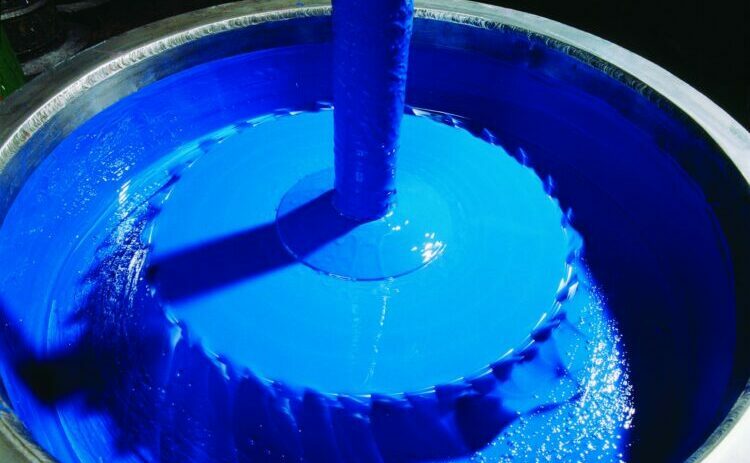Emphasize Increased Efficiency, Productivity, Agility, and Flexibility While Maintaining Quality and Safety
By Cynthia Challener, CoatingsTech Contributing Writer
Core paint and coatings manufacturing processes have remained largely unchanged since the dawn of the industry. Ingredients are mixed into a liquid (organic solvent or water), a process that is often followed by milling to achieve the correct particle size for products comprising dispersions. Despite this, the paint and coatings industry is very dynamic. Business trends, market demands, governmental regulations, scientific innovations, and other forces are continually prompting changes that call on manufacturing equipment suppliers to provide new solutions.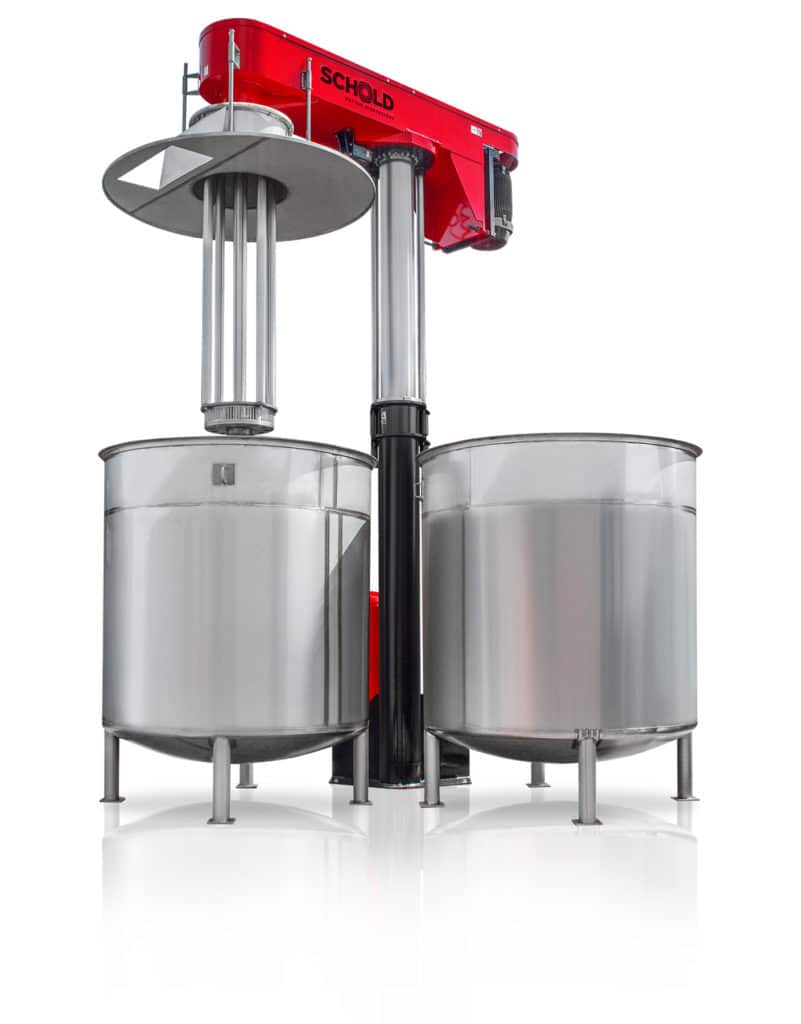
One such change, the move from normal steel to a primarily stainless steel construction for high-speed dissolvers (HSD), occurred over the last 70–80 years, according to Hans-Joachim Jacob, senior process engineer and customer application specialist at ystral gmbh maschinenbau + processtechnik. “HSDs are low-shear machines, but high-shear forces are often required for proper dispersion of paint ingredients. These forces can be generated by increasing the viscosity, but the viscosity changes from the start to the end of a process, requiring careful control by the operator. As a result, processes today are still heavily influenced by the specific operator, and a cyclical mix—quality check—adjust with additives and repeat system is used that can be time consuming,” he observes. Jacob believes it is time for a change. “Instead of relying so heavily on additives to solve performance issues,” he says, “the industry should be doing more with technology, such as to prevent foaming.”
Other changes, such as to formulations and batch sizes, have made it a challenge to produce new products in legacy assets, according to Stuart Rae, advanced manufacturing director at AkzoNobel. “There is need for greater agility to handle smaller batch sizes with the same levels of efficiency and cost, even for formulations that have lower levels of biocides, so they require higher levels of hygienic conditions. The reduction in biocide use for consumer water-based products has, in particular, created challenges to ensuring product quality given existing raw material quality, storage, and legacy plant designs. Smaller production orders, meanwhile, require the same cleaning times and incur higher residual losses, and thus process and product redesign are needed to enable sustainable manufacturing under current conditions,” he explains.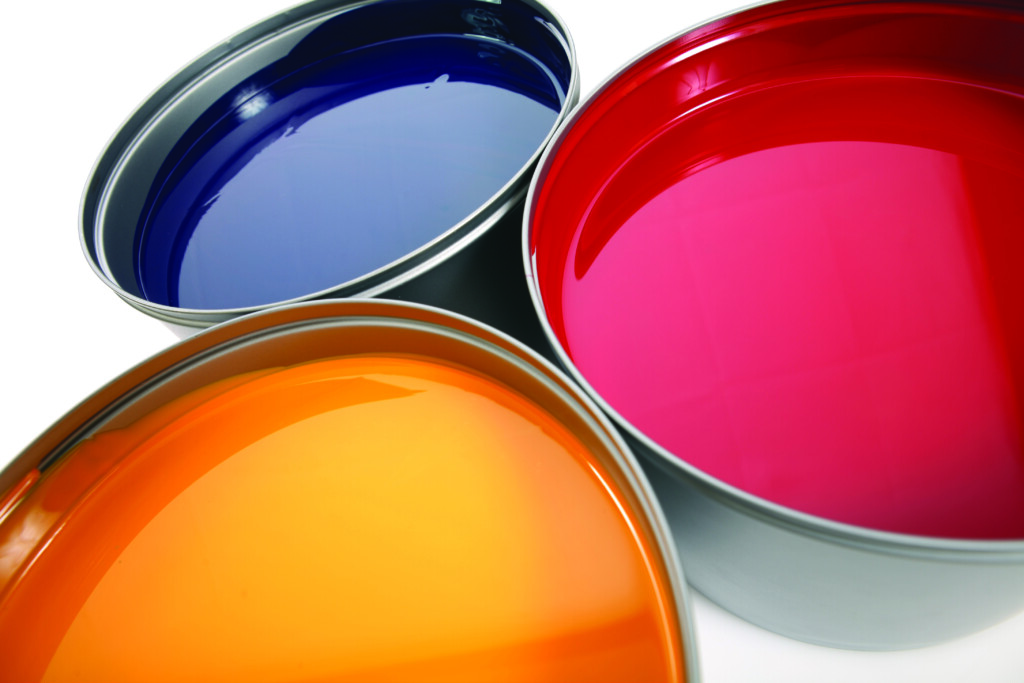
In addition to cost-effective performance, equipment reliability is fundamental, adds Stewart Rissley, chemical market manager with Admix.
Echoing that sentiment, Sara Fulford, VP of sales and marketing for Hockmeyer Equipment Corporation, says, “Achieving the delicate balance between productivity and consistently manufacturing a high-performance product is the top priority.”
With so many options and elements to consider—and with limited time and resources—it can be difficult to identify equipment that maximizes efficiency and performance. “Customers have to find a way to sensibly assess how equipment will perform for their unique products. It has to fit into their current process seamlessly and ideally eliminate steps to enable leaner processes without requiring reformulation. Factors such as cost, space requirements, manpower, cleanability, ergonomics, safety, and reliability also have to be considered,” Fulford advises.
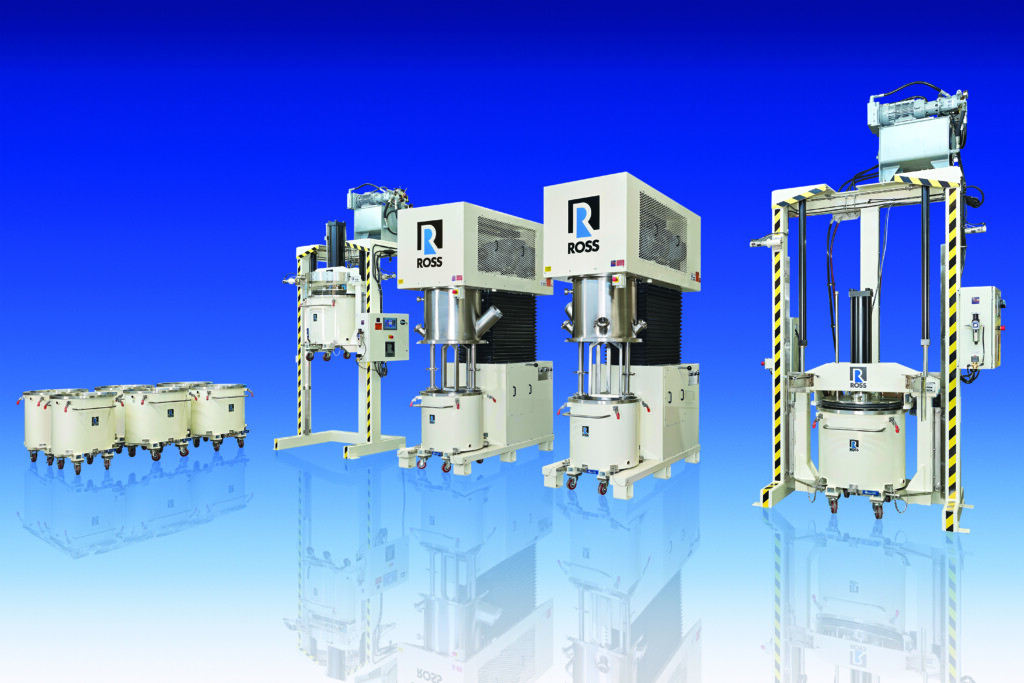
Indeed, time is money, and the less time it takes to process a product, the better, adds Schold sales engineer Amy Karony. Improvements in milling efficiency can significantly affect processing time, for instance. Whereas long residence times may be necessary in many horizontal mills, Karony says Schold has found that processing time can be reduced by up to 50% or more in certain applications by replacing horizontal milling operations with immersion or basket mills.
Due to tight budgets in the current business climate, many paint manufacturers use a single piece of equipment in the production of coatings products with very different properties. In these cases, versatility is essential. Karony points to thin and extremely viscous products as an example that requires different gearing and/or additional blades to ensure proper mixing. Versatility of equipment is also needed with respect to batch volumes, she notes, pointing to the wide range of batch sizes many smaller-volume coatings manufacturers make on any given day or week. “Post-mounted/tank-mounted batch-style machines can be used only for certain volume sizes that aren’t sufficient to meet the volume ranges many customers have today,” Karony says.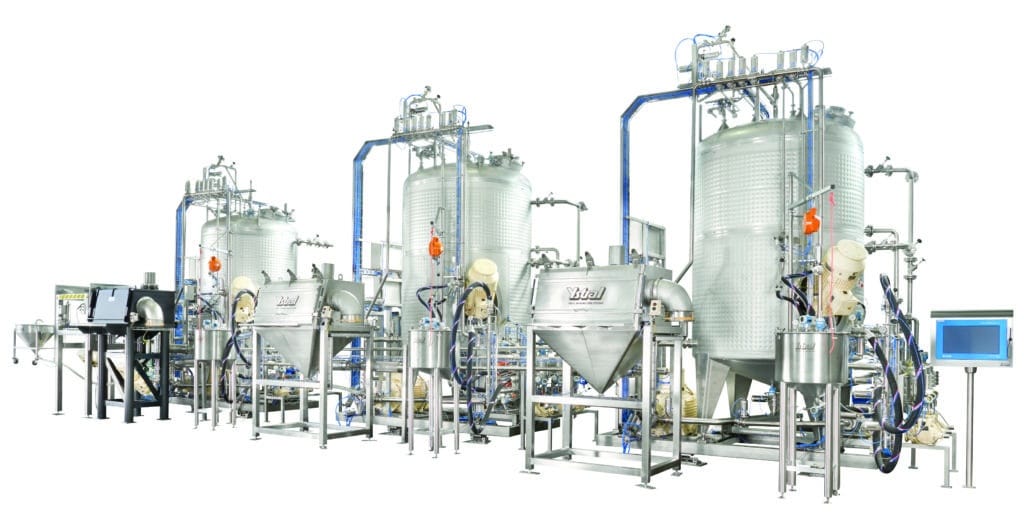
Jacob adds that paint processing equipment should also be flexible enough to enable everything from color changes to switches in resins and other ingredients that might be incompatible. “The ability to produce different batch sizes and different product types using a single system allows coating manufacturers to invest more in one system, because it can replace multiple pieces of older equipment,” he says.
Greater knowledge of mixing within the paint industry is also needed, according to Jacob. “The type of tank and agitator system should be chosen based on the specific application. A process tank, for instance, requires higher performance and a higher power-per-volume ratio than a simple storage tank,” he explains. Solventborne and waterborne formulations also have different requirements; with its higher surface tension and polarity, mixing powders into water requires much higher power/energy concentration, Jacob notes. Powder handling in all paint production processes presents another challenge for the industry with regard to protection of operators from breathing in fine dust particles and eliminating explosion hazards associated with the addition of powders from the top of the tank. Scale up from lab to the plant can be another challenge, particularly in Europe; in the United States and many other countries, intermediary pilot scale runs are performed using scale-down production equipment with the same shear speeds, flow rates, and energy/power densities as large-scale plant equipment to ensure processes are optimized for in-plant conditions.
Remote Operation and Digitalization
One of the most important technology developments enabling greater efficiency and productivity combined with consistent quality and enhanced operator safety is digitalization of process equipment for remote, automated operation. “In the past, liquid mixing
has been somewhat of an art, but as more and more companies move to reduce human operators in the interest of both cost and safety concerns, the [greater the] need for consistency and quality improvements, and as lab-developed formulations have become more and more unique, even in smaller operations, companies are moving toward automated or semi-automated equipment to aid with quality control,” Karony explains.
Indeed, the ability to run lights-out once a batch has been started increases productivity and can reduce costs significantly, Barry Cullens, director of R&D and process applications for Hockmeyer Equipment Corporation, adds.
Some equipment manufacturers report growing interest in the ability to operate production equipment remotely. “In this age of connectivity,” says Christine Banaszek, sales manager for Charles Ross & Son Company, “a growing number of our customers are interested in adding a Remote Access Device (RAD) for their Ross Mixers. With this technology, operators and supervisors with an internet connection can monitor and control machines remotely. In some cases, that even includes the use of a central base located in another building, city, or even country, allowing the same recipes to be produced in the same manner regardless of location,” according to Jacob.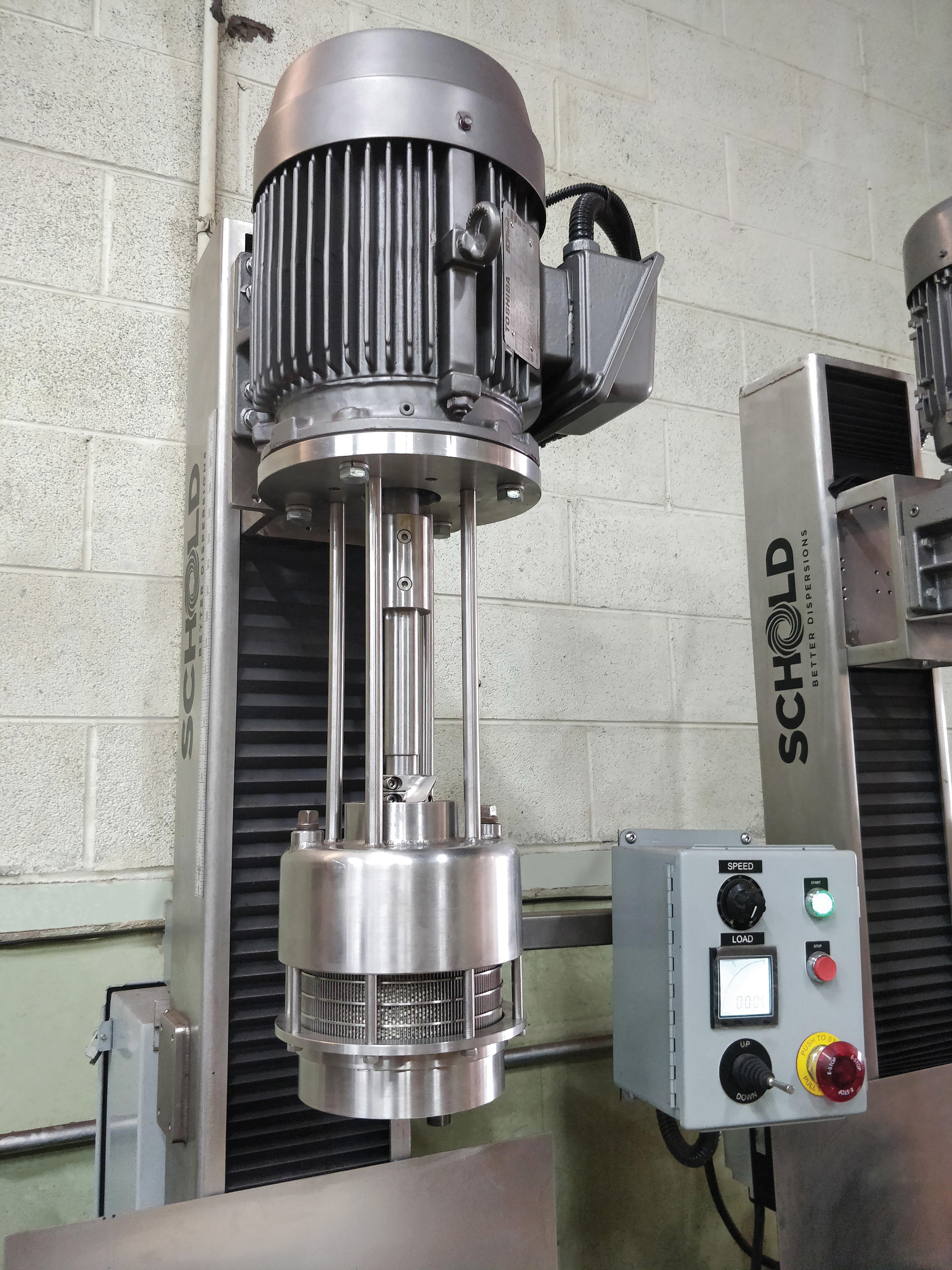
Others, however, anticipate a future that continues to draw on operator skill with assistance from new technologies such as remote operation. Cullens believes, for example, that given the current level of incoming raw material batch-to-batch inconsistencies, there will always be some level of operator activity, even under the most technologically advanced, remotely controlled environment. “It is unlikely that we will see complete hands-free operation; there will always be some art mixed in with the science,” Fulford says.
A complementary trend is continuous data acquisition, a process that is generally facilitated by the use of automated systems. Jacob reports that systems exist today that contain all of the recipes produced on a production line with the capability to automatically schedule runs in an order that optimizes switches from one batch to another, minimizing cleaning requirements. There are even some self-teaching systems that can continuously learn about dosing conditions after each run and apply that learning to improve operations for the next run.
Digitalization is a tool for quality control. “Manufacturers are opting for customizable recipe-control systems capable of logging all process variables to a CSV [comma-separated value] file of batch history records,” Banaszek says.
Digitalization is also a tool for increasing equipment longevity. “Customers like to have a maintenance screen incorporated into the mixer control panel that can display automated reminders for preventive maintenance duties such as checking belts, greasing bearings, etc.,” Banaszek explains.
Mixing Technology
Greater efficiency is also being achieved with the introduction of newer mixing technologies. For coating manufacturers that prefer to continue using HSDs to combine dry and wet raw materials, reliability, robust design, and ample horsepower are still the main considerations, according to Banaszek. For other companies, innovative designs offer an opportunity to further extend processing flexibility and decrease downtime. As one example, she points to a swivel design disperser that is raised out of the tank at the end of 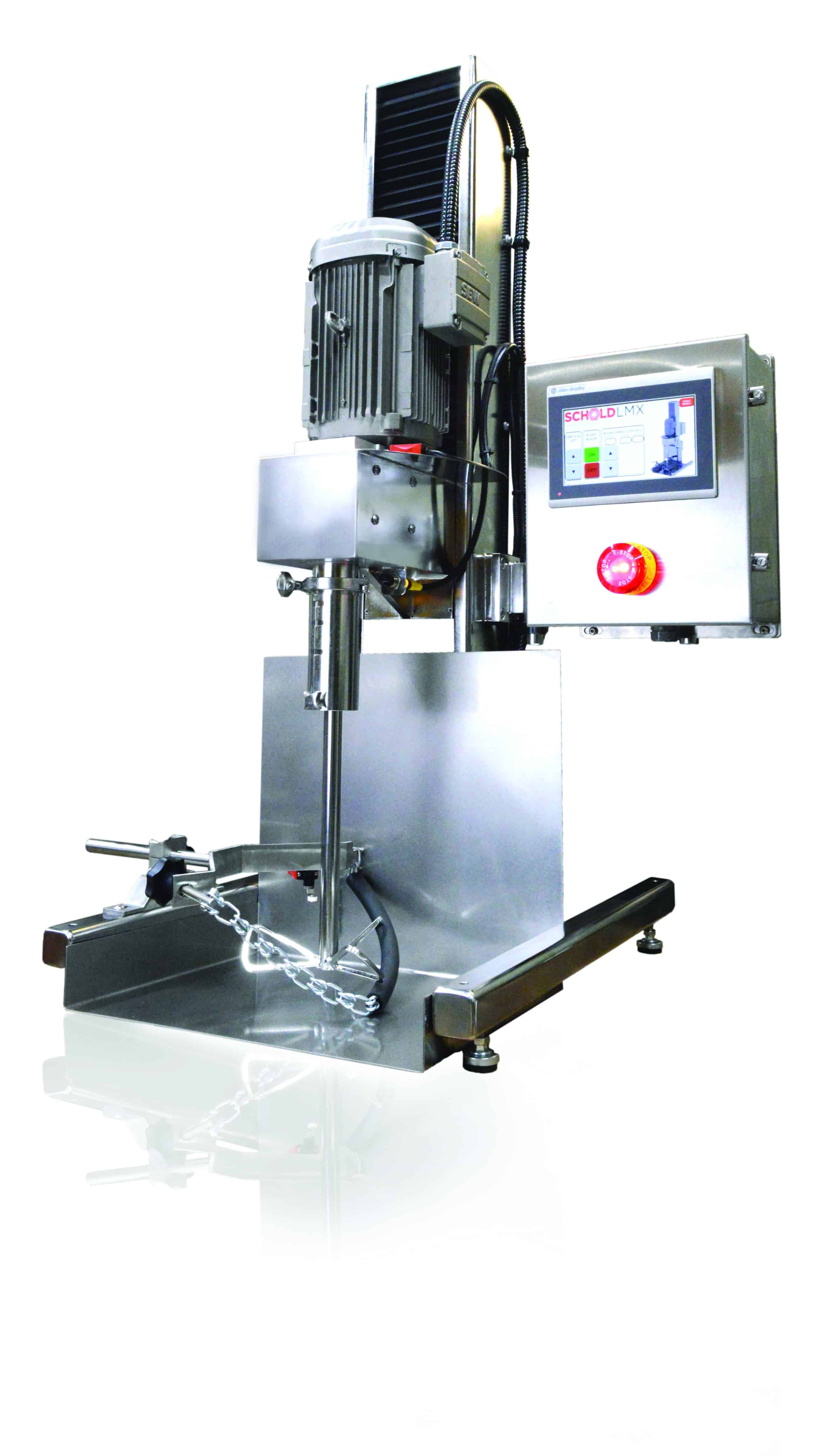 the mixing cycle and rotated 90 degrees to service another vessel while the first tank is drained and set up for the next run. Admix, meanwhile, has developed high-shear technology that performs reliably with lower power consumption compared to legacy equipment, affording greater energy efficiency, according to Rissley. He notes batch times are greatly reduced and that rapid production of 100% powder dispersions is possible, because the company’s patented high-shear head design provides the optimal balance between shear and flow. “With high flow, there are no dead zones in the tank, and, therefore, the product passes through multiple shear zones/surfaces in a short amount of time, resulting in agglomerate-free mixtures in under 10 minutes,” Rissley asserts. The technology is suitable for both large and small batches and, therefore, ideal for customers serving smaller and/or more diverse markets.
the mixing cycle and rotated 90 degrees to service another vessel while the first tank is drained and set up for the next run. Admix, meanwhile, has developed high-shear technology that performs reliably with lower power consumption compared to legacy equipment, affording greater energy efficiency, according to Rissley. He notes batch times are greatly reduced and that rapid production of 100% powder dispersions is possible, because the company’s patented high-shear head design provides the optimal balance between shear and flow. “With high flow, there are no dead zones in the tank, and, therefore, the product passes through multiple shear zones/surfaces in a short amount of time, resulting in agglomerate-free mixtures in under 10 minutes,” Rissley asserts. The technology is suitable for both large and small batches and, therefore, ideal for customers serving smaller and/or more diverse markets.
Inline mixing is another important advance in efficiency. Schold offers inline disperser models that provide the opportunity to combine mixing wet and dry product with the use of a rotor stator to also achieve significant particle size reduction in one pass for many raw materials, according to Karony. She adds that the equipment is also offered as a portable skid system, providing the agility needed to meet manufacturer expectations for flexible production solutions. The portable skid includes the Schold inline disperser, a small tank, and various equipment additions such as a powder introduction inlet and/or tank agitator. “Originally developed in response to the recent high demand for industrial detergents and sanitizers, interest in this type of equipment is extremely high in the current atmosphere and also finding wide use by customers in various industries, including the paint and coatings sector, that need versatile and portable solutions to many different processes in their plants,” states Karony.
Vacuum Systems
Rapid-flow vacuum milling and dispersion technology, meanwhile, is designed to enhance efficiency for customers trying to make more batches, faster, with less waste and easier changeovers, according to Fulford. Hockmeyer has developed a line of equipment for dispersing, milling, and homogenizing under vacuum that removes air trapped in the feedstocks to facilitate faster, purer particle size reduction and deagglomeration. It can thus reduce process times significantly, increasing productivity and yields, she says. In some cases, Cullens notes that the technology allows formulators to incorporate less or maybe even no defoamers, which can be advantageous from both performance and cost perspectives.
The dispersion under vacuum expansion from ystral provides more than enhanced efficiency, according to Jacob. Because powder is drawn into a recirculating loop via a vacuum, it has already been wetted before entering the tank, avoiding the risk of explosion and reducing operator exposure. He notes that the expanded distance between the individual particles under vacuum also means that single particles are dispersed, and agglomeration is largely avoided, eliminating the need for milling in nearly 80% of cases. A residence time of less than a second under shear force allows for the use of shear-sensitive ingredients, according to Jacob. Separate from the actual mixer, the system also works with many different tanks sizes and can be cleaned in place for rapid changeover without risk of cross-contamination of different pigment colors or other ingredients. It can additionally enable substantial reduction of the amount of wetting agent needed. This is because the powder is not being added to the top of the tank and may result in less hydrophilic surfaces that, in architectural applications, could lead to a reduced need for biocides.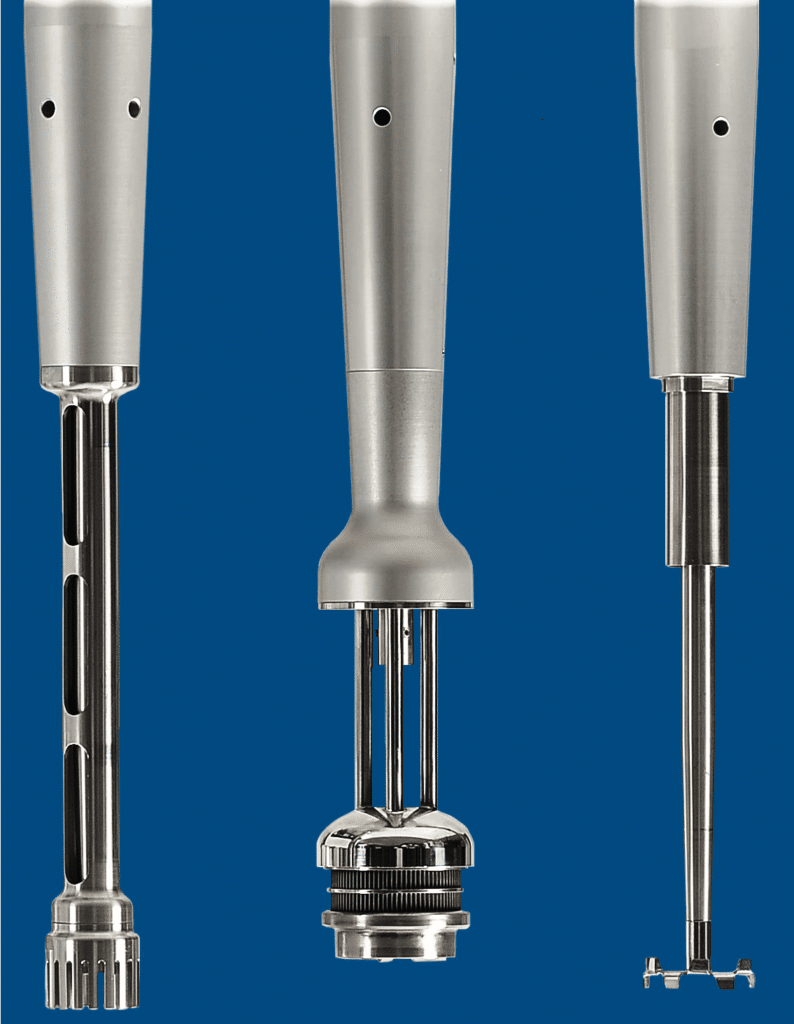
For high-value and high-performance coatings, a closed mixing system is preferred by end users, according to Banaszek. For example, she says the Charles Ross & Son Company custom-builds multi-shaft mixers and planetary dispersers for coatings applications in the electronics, aerospace, medical, and other markets. These machines “are especially capable of high-viscosity mixing under vacuum and at precise temperatures,” she says. For such specialized solutions, Banaszek says it is best to begin product development in partnership with a reliable equipment manufacturer and select a scalable R&D mixer to eliminate common issues that often occur when scaling up to full-scale production.
Schold, meanwhile, has developed a vacuum solution for mixing within drums and smaller vessels in response to customer requests. “We have a great many customers mixing and producing their products right in 55-gal drums for downstream process convenience. Our solution makes it extremely simple to secure the drum under the mixer, lower the vacuum bell, pull full vacuum, and process the batch. It removes the complexity of vacuum mixing and the need for specific vacuum-rated mix vessels,” she explains.
Simplified Manufacturing
Two other developments from equipment manufacturers are supporting trends within the coating industry to simplify manufacturing. In one case, because manufacturing continues to move to ever larger production batches, producers have been interested in adopting powder-feed systems rather than handling hundreds of 50-lb bags per batch, according to Cullens. Instead, powders are being delivered to paint manufacturing plants in intermediate bulk containers or even rail cars/tankers for incorporation into production processes using automated feeding systems. Fulford expects the use of such auto-feed powder systems will continue to grow as an equipment category in the coatings space.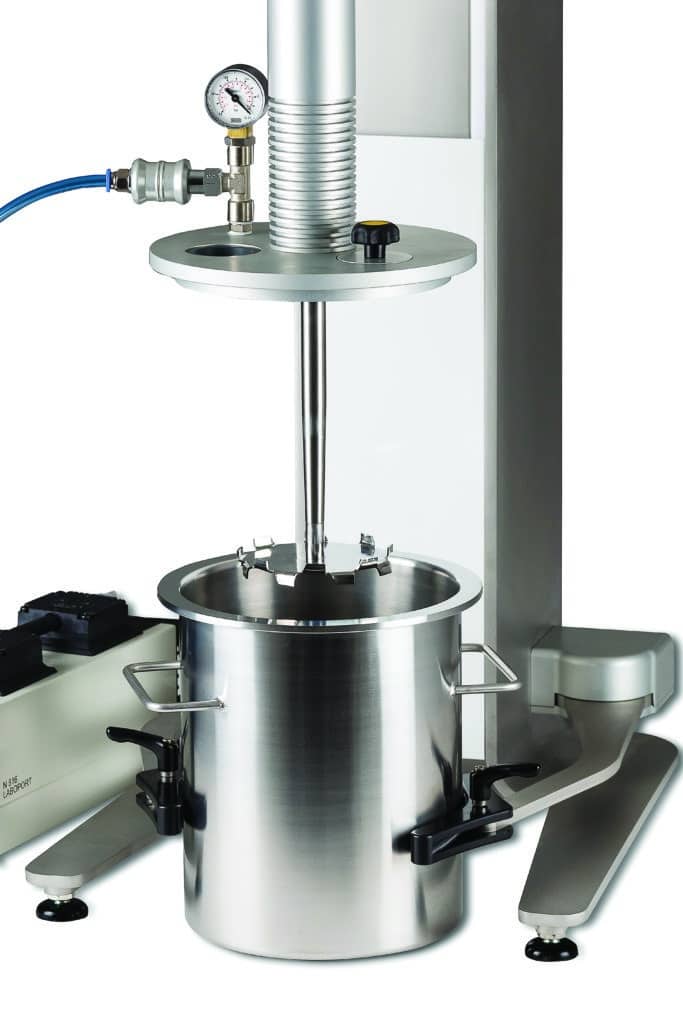
The other concept seeing greater acceptance, particularly in Asia, is the production of intermediate slurries, such as of titanium dioxide, which are optimally dispersed and then stored on site for a period of time. Slurries with multiple ingredients can also be made. This approach is particularly efficient if the same slurries can be used for the production of multiple products and an automated system is used for the final product mixing.
Paint manufacturers of all sizes are leveraging all of these new technologies to some degree. “We are working with suppliers and product formulators to apply agility in design and in the way products are manufactured through a range of different options; this
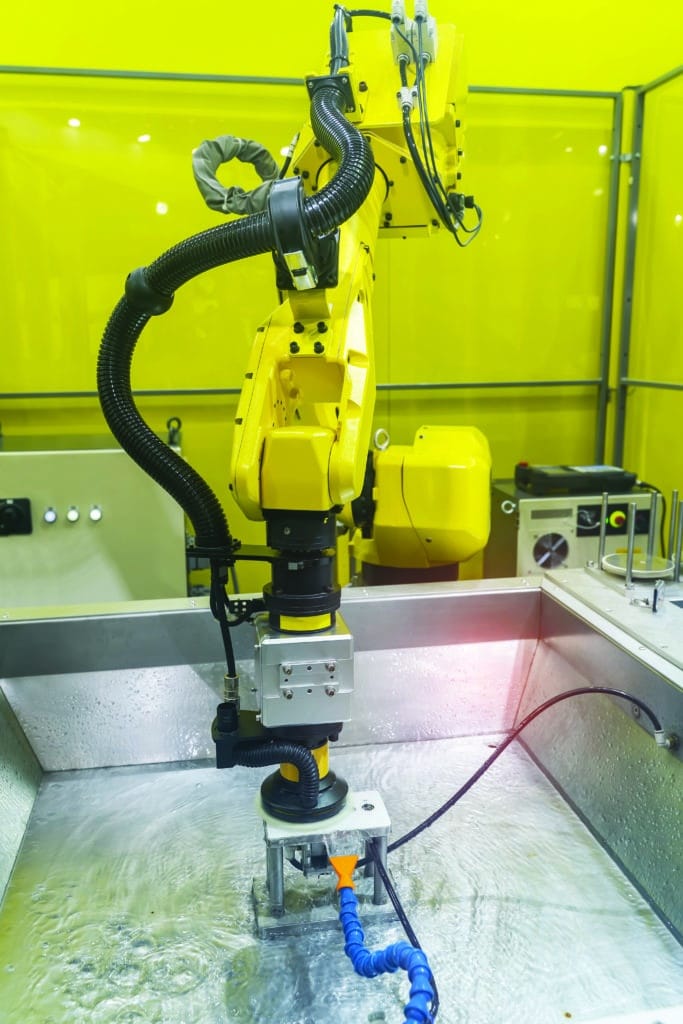
includes manufacturing from intermediates, filling lines designed for rapid changeovers, late differentiation of items, and modifications to improve yield on smaller production runs,” Rae states. AkzoNobel has also implemented in recent years various processes and technology to improve the recovery and reuse of by-products to reduce waste, increase material efficiency, and deliver savings. Currently, Rae notes the company is interested in solutions that will further enable late differentiation of products through efficiency in filling operations and the decoration of packaging.
Working with Novel Materials
Though novel and complex materials used in coating formulations may present challenges, those challenges are positive ones that can be translated into opportunities, reasons Rissley. Admix technology, for instance, can be configured into low-/high-shear devices for batch and continuous process modes, he notes.
Processing equipment must also be able to convert lower-quality materials into high-quality end products, observes Karony, given that companies are switching to lower-quality materials to reduce raw material costs. “Machines such as inline dispersers and immersion mills that are designed to inherently provide for waste minimization and increased raw material utilization are important solutions for this issue,” she says.
Nanomaterials have also become important in coating formulations, and many require special processing conditions. Pigments that are purposely processed to the nanosize, for instance, often have coatings applied to them to prevent re-agglomeration. “It is important to separate these particles without removing the coatings, and, therefore, new milling techniques address this need for what appear to be paradoxical processes,” Fulford says.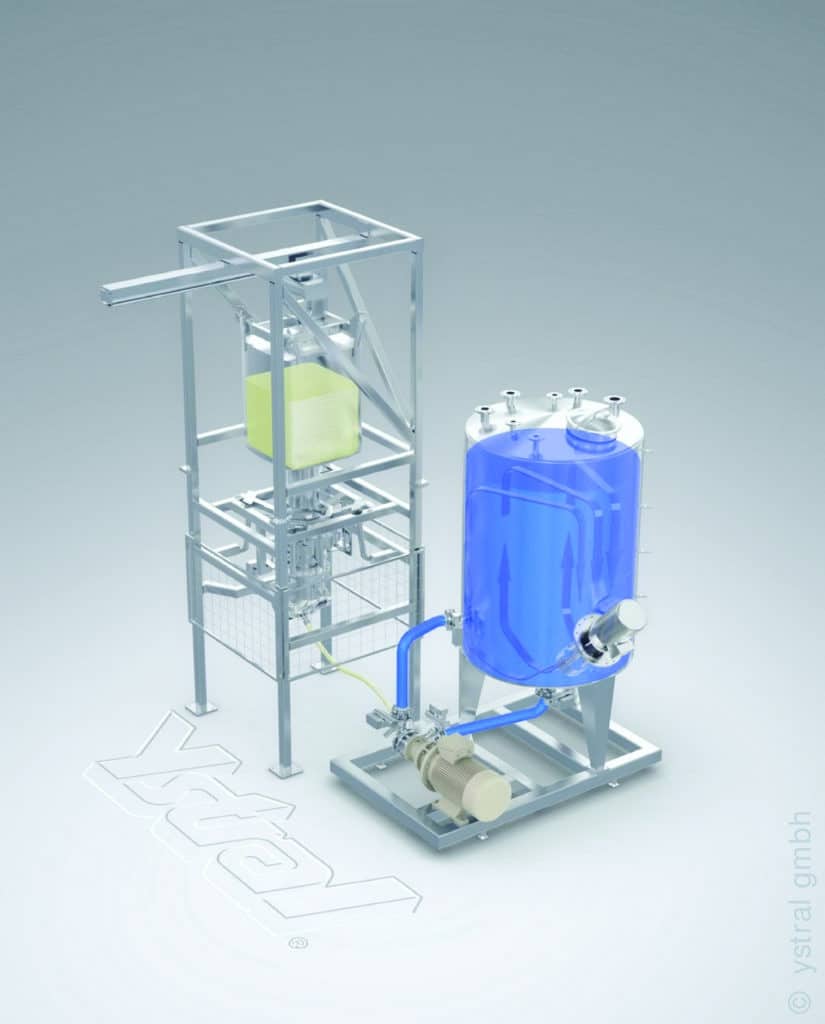
Other pigments are not nanoscale but have special shapes (i.e., sheet form or ball form flakes) that must be preserved for them to perform properly. “For these formulations, mill speed, media size, and media density all play a role and have to be carefully balanced, and often vacuum milling rather than atmospheric milling is the only way to achieve the desired results,” Cullens observes.
For many new resin and additive technologies, temperature control has become an important process parameter. “Over the past 30 years, we have seen a steady decrease in maximum batch temperature due to new resins, pigments, nano dispersions, applications, etc.,” Cullens comments. With inline mixing, the processing temperature can be controlled to fit the formulation by adding inline jacketed tubes either before or after the processing equipment. “The cooling efficiency of inline heat exchangers is much greater than just having a cooling jacket on the supply tank. In fact, with the rapid flow rates used to disperse or mill materials, the maximum batch temperature will dictate the mill or disperser speed to maintain the feedstock under the maximum temperature. Running the mill slower will reduce the impact between the media and the rotating parts, thus limiting the equipment capabilities and can greatly increase processing times or prevent the desired particle size from being attainable,” he explains. With inline cooling, on the other hand, it is possible to operate a mill or disperser at full speed, maximizing the throughput without high-temperature issues, Cullens concludes.
New equipment available today also makes it possible to manufacture materials that cannot be produced using high-speed dissolvers, according to Jacob. With the dispersion under vacuum expansion technology, for example, the ability to control the amount of heat generated enables the production of sol-gel systems, including plastisols and organosols, that cure at temperatures near 100 °F and 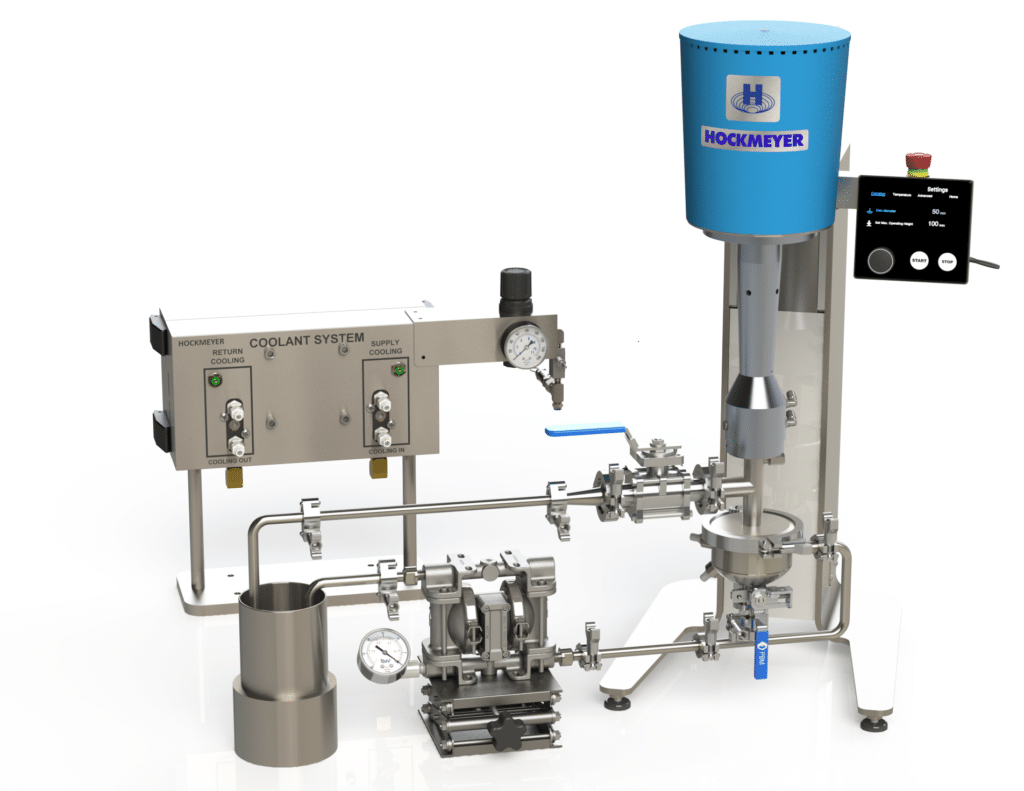 can only be produced at temperatures below 90 °F. Vacuum systems also make it possible to incorporate extremely light fillers (nanosized bubbles filled with gas), which cannot be added by pouring out of a bag, for light-weighting as well as for use in cool-roof coatings for diffraction and reflection of infrared light. Inline dispersion also increases the effectiveness of novel dispersing additives comprising backbones with long side chains. These additives are often destroyed when added to dissolver tanks at the beginning of the mixing process; controlled addition at the right time is possible with the use of inline mixing technology, according to Jacob. Similarly, working at different pH levels in the tank and in the inline mixer makes it possible to control the addition of pH-activated materials to coating products.
can only be produced at temperatures below 90 °F. Vacuum systems also make it possible to incorporate extremely light fillers (nanosized bubbles filled with gas), which cannot be added by pouring out of a bag, for light-weighting as well as for use in cool-roof coatings for diffraction and reflection of infrared light. Inline dispersion also increases the effectiveness of novel dispersing additives comprising backbones with long side chains. These additives are often destroyed when added to dissolver tanks at the beginning of the mixing process; controlled addition at the right time is possible with the use of inline mixing technology, according to Jacob. Similarly, working at different pH levels in the tank and in the inline mixer makes it possible to control the addition of pH-activated materials to coating products.
Supporting Small Coating Manufacturers
Smaller shops generally want smaller, high-quality equipment that is also reliable and affordable, according to Rissley.
Versatility is also essential. “Small shops that focus on the development of formulas using emerging technologies need equipment that is readily adaptable, with the ability to serve multiple functions, process a wide variety of materials, and capture data for thorough detailed analysis,” states Fulford. “These environments call for machines that are designed to achieve fast and reliable results and accurate scale up with safe, ergonomic designs, due to substantial hands-on operator involvement,” she adds.
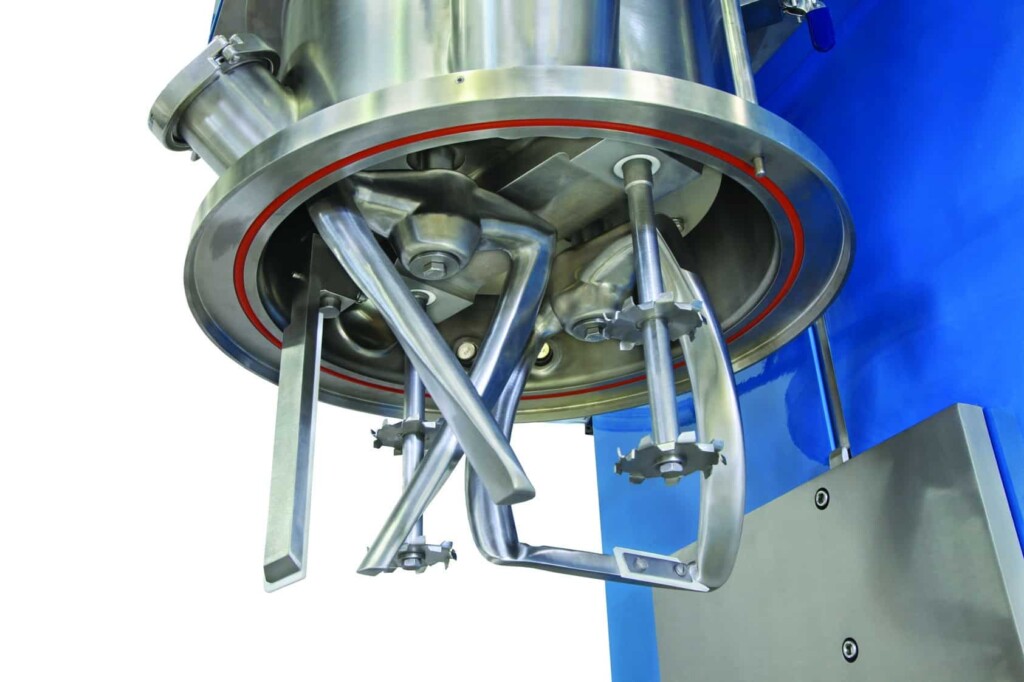
In addition to being versatile, they must also be robust and provide agility via quick changeovers and shorter production runs, because these capabilities are what afford small shops their economic advantage over larger companies, according to Karony. For instance, she notes that for low-viscosity products, the cleanup time can be reduced substantially by purchasing CIP equipment. “If the solvent used in cleaning is compatible with the end-product, the cleaning solution can be blended into the letdown to eliminate raw material waste, further improving safety, environmental, and housekeeping practices by not having a person manually clean the machine,” she adds.
With HSDs, the bottleneck is usually quality control and adjustment, with the total batch time reaching five hours or greater, but operator involvement at perhaps two hours, according to Jacob. With inline mixing technology such as the system ystral offers, the bottleneck becomes powder handling, and the run time is optimized when unloading of the powder into the hopper is optimized. This situation is an additional driver for the use of automated powder feeders.
It is also driving interest in the production and use of intermediate slurries for the most difficult to handle and important raw materials, even at smaller coatings producers, Jacob observes.
Providing equipment that can be used at different scales and for different functions is also important. Most companies are now offering scale-down versions of plant equipment for use in the R&D and pilot settings. Schold, for instance, has developed a lab mixer that can be used in the R&D lab and for quality control testing that is capable of blending, mixing, dispersing powders, homogenizing, emulsifying, and even milling lab-size batches on the same frame, according to Karony. It can also provide vacuum or heated/cooled processing and can be built with three different motor sizes, allowing use for a wider range of batch sizes. “The operator can change attachments to fulfill various lab needs and thus eliminate the need for four different machines, which in turn reduces the amount of capital investment needed for a lab,” Karony says.
Hockmeyer has also developed lab and pilot-sized units that can be adapted to agitate, mix, disperse, homogenize, mill and nano-mill materials up to 500,000 centipoise (cps), according to Fulford. Notably, the systems can work under atmospheric or vacuum conditions, and the temperature of the feedstock can be easily regulated. Furthermore, customization to include rapid recirculation under vacuum technology is also possible, comments Fulford.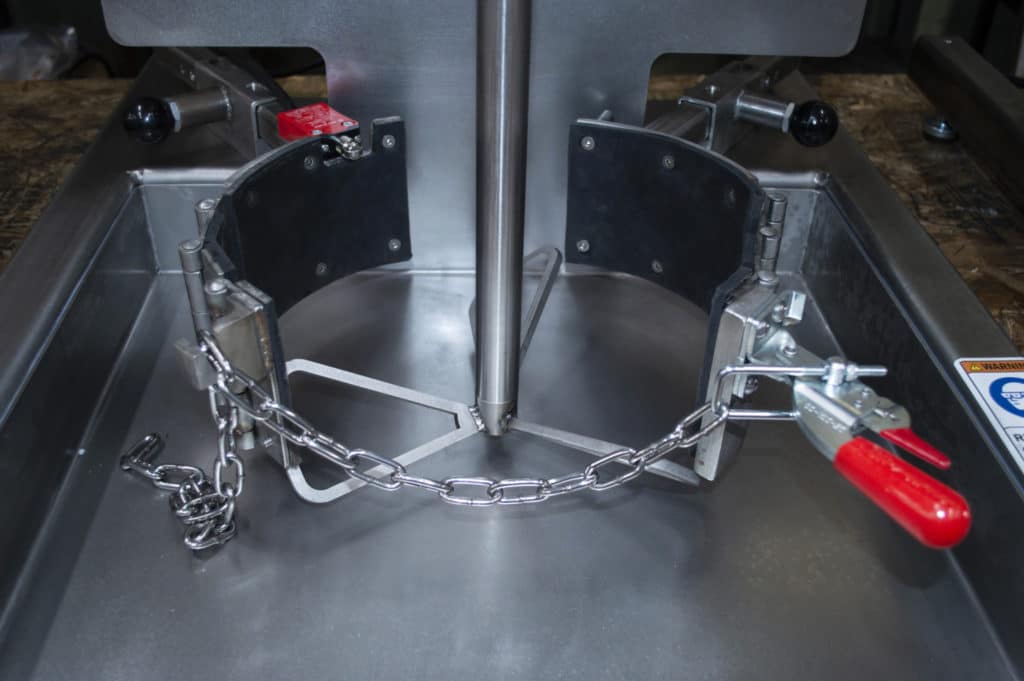
The key to providing optimum solutions for smaller shops, Rissley asserts, is listening to the “Voice of the Customer” and providing customized solutions for the given application. “To help customers avoid the trap of selecting low-cost equipment that underperforms and results in lower yields or the use of outdated and inefficient technologies that can’t keep up with production demands, Admix partners with customers to understand their applications, ingredients used, end-product quality goals and current capacities versus demands. We are then, using our long ingredient and applications experience, able to customize high-performing, built-to-last solutions that greatly improve their current processes and result in increased yields and the highest quality end-products possible,” he says.
Schold is also a custom equipment manufacturer and works with shops to alter equipment as needed to meet their specific plant footprint and processing needs and to support the transition to more automated processes, according to Karony. “Currently no one machine can continuously and properly incorporate all ingredients AND reduce particle size. Schold can help assess the application and facility situation from greenfield projects to line expansions and by using our expertise in the industry and our equipment knowhow and system design experience to develop unique solutions that help our clients reduce bottlenecks and create balanced processes,” she states.
CoatingsTech | Vol. 17, No. 9 | September 2020
